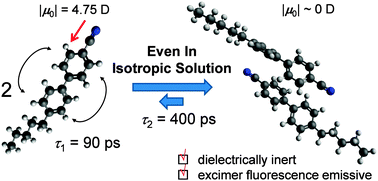Evidence of anti-parallel dimer formation of 4-cyano-4′-alkyl biphenyls in isotropic cyclohexane solution
Abstract
The formation of anti-parallel dimers of two liquid crystal forming 4-cyano-4′-alkyl biphenyls (nCB, n = 5 (pentyl) and n = 8 (octyl)) was confirmed in an isotropic cyclohexane solution (nCB–cH). In addition to high frequency dielectric relaxation (DR) measurements up to 50 GHz, fluorescence emission (FE) experiments in the wavelength range from 280 to 500 nm were carried out to investigate the molecular dynamics of the nCB molecules. The DR spectra of solutions at intermediate to high concentrations were comprised of two dynamic modes. A fast mode with a relaxation time of ca. 90 ps was assigned to the free rotations of monomeric nCB molecules. The slow mode with a relaxation time of ca. 400 ps was attributed to the dissociation process of the anti-parallel dimers ((nCB)2). The Kirkwood factor (gK), a measure of the orientational correlation between the dipole moments of the cyano groups, was markedly less than unity for the slow mode, which demonstrated the formation of anti-parallel dimers, (nCB)2. The equilibrium constant for anti-parallel dimer formation in an isotropic solution, i.e., for the reaction, 2nCB ↔ (nCB)2, which was determined via the DR data increased with an increase in the concentration of nCB. Under extremely dilute conditions, a sharp fluorescence emission signal attributed to the nCB monomer was observed at 325 nm in FE spectrum measurements. However, at the moderate to high concentrations used in the DR measurements where the slow mode was clearly observed, a broad FE signal at 390 nm was observed, which was assigned to excimer emission (including emission from the excited ground state dimers). The relative intensity of the excimer emission to the monomer emission significantly increased with an increase in the concentration. Moreover, the equilibrium constant for the excimer formation reasonably agreed with that for the anti-parallel dimer formation evaluated by the DR data. Consequently, the results of the FE measurements evidently revealed that excimers of nCB and the (nCB)2 dimers formed in isotropic solution are identical chemical species.


 Please wait while we load your content...
Please wait while we load your content...